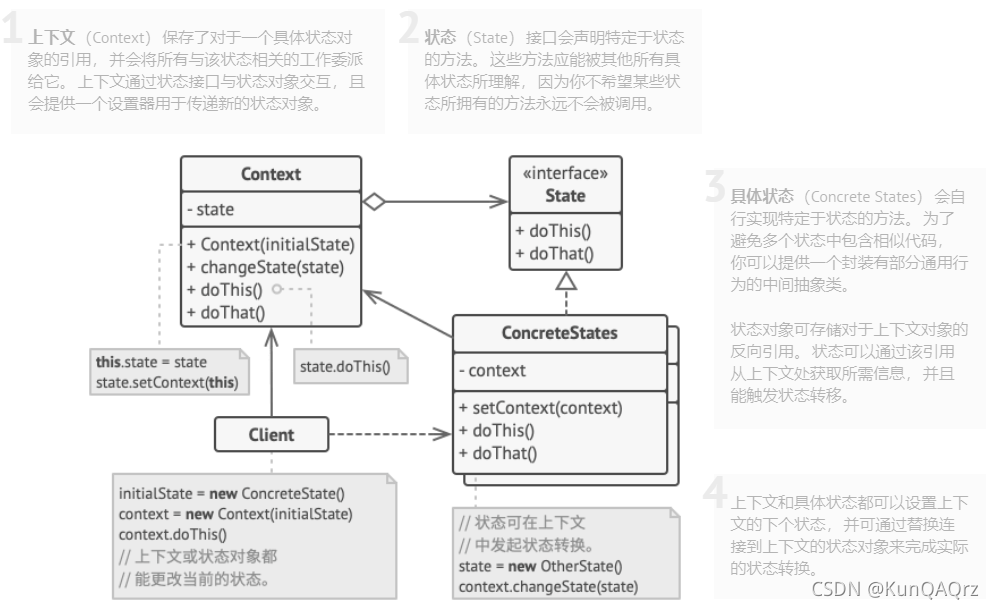意图
策略模式能让你定义一系列算法,并将每种算法分别放入独立的类中,以使算法的对象能够相互替换。

问题
你打算为游客们创建一款导游程序。 现在需要的功能是自动路线规划:他们希望输入地址后就能在地图上看到前往目的地的最快路线。
程序的首个版本只能规划公路路线。驾车旅行的人们对此非常满意。但很显然,并非所有人都会在度假时开车。因此你在下次更新时添加了规划步行路线的功能。此后,你又添加了规划公共交通路线的功能。不久后,你又要为骑行者规划路线。又过了一段时间,你又要为游览城市中的所有景点规划路线。
导游代码将变得非常臃肿。
尽管从商业角度来看, 这款应用非常成功, 但其技术部分却让你非常头疼: 每次添加新的路线规划算法后, 导游应用中主要类的体积就会增加一倍。 终于在某个时候,你觉得自己没法继续维护这堆代码了。
无论是修复简单缺陷还是微调街道权重,对某个算法进行任何修改都会影响整个类,从而增加在已有正常运行代码中引入错误的风险。此外,团队合作将变得低效。
如果你在应用成功发布后招募了团队成员,他们会抱怨在合并冲突的工作上花费了太多时间。在实现新功能的过程中, 你的团队需要修改同一个巨大的类,这样他们所编写的代码相互之间就可能会出现冲突。
解决方案
策略模式建议找出负责用许多不同方式完成特定任务的类,然后将其中的算法抽取到一组被称为策略的独立类中。
名为上下文的原始类必须包含一个成员变量来存储对于每种策略的引用。上下文并不执行任务, 而是将工作委派给已连接的策略对象。
上下文不负责选择符合任务需要的算法——客户端会将所需策略传递给上下文。实际上,上下文并不十分了解策略,它会通过同样的通用接口与所有策略进行交互,而该接口只需暴露一个方法来触发所选策略中封装的算法即可。
因此,上下文可独立于具体策略。这样你就可在不修改上下文代码或其他策略的情况下添加新算法或修改已有算法了。

在导游应用中, 每个路线规划算法都可被抽取到只有一个 buildRoute生成路线方法的独立类中。 该方法接收起点和终点作为参数, 并返回路线中途点的集合。
即使传递给每个路径规划类的参数一模一样, 其所创建的路线也可能完全不同。 主要导游类的主要工作是在地图上渲染一系列中途点, 不会在意如何选择算法。 该类中还有一个用于切换当前路径规划策略的方法, 因此客户端 (例如用户界面中的按钮) 可用其他策略替换当前选择的路径规划行为。
策略模式结构

示例
/**
* The Strategy interface declares operations common to all supported versions
* of some algorithm.
*
* The Context uses this interface to call the algorithm defined by Concrete
* Strategies.
*/
class Strategy
{
public:
virtual ~Strategy() {}
virtual std::string DoAlgorithm(const std::vector<std::string> &data) const = 0;
};
/**
* The Context defines the interface of interest to clients.
*/
class Context
{
/**
* @var Strategy The Context maintains a reference to one of the Strategy
* objects. The Context does not know the concrete class of a strategy. It
* should work with all strategies via the Strategy interface.
*/
private:
Strategy *strategy_;
/**
* Usually, the Context accepts a strategy through the constructor, but also
* provides a setter to change it at runtime.
*/
public:
Context(Strategy *strategy = nullptr) : strategy_(strategy)
{
}
~Context()
{
delete this->strategy_;
}
/**
* Usually, the Context allows replacing a Strategy object at runtime.
*/
void set_strategy(Strategy *strategy)
{
delete this->strategy_;
this->strategy_ = strategy;
}
/**
* The Context delegates some work to the Strategy object instead of
* implementing +multiple versions of the algorithm on its own.
*/
void DoSomeBusinessLogic() const
{
// ...
std::cout << "Context: Sorting data using the strategy (not sure how it'll do it)\n";
std::string result = this->strategy_->DoAlgorithm(std::vector<std::string>{"a", "e", "c", "b", "d"});
std::cout << result << "\n";
// ...
}
};
/**
* Concrete Strategies implement the algorithm while following the base Strategy
* interface. The interface makes them interchangeable in the Context.
*/
class ConcreteStrategyA : public Strategy
{
public:
std::string DoAlgorithm(const std::vector<std::string> &data) const override
{
std::string result;
std::for_each(std::begin(data), std::end(data), [&result](const std::string &letter) {
result += letter;
});
std::sort(std::begin(result), std::end(result));
return result;
}
};
class ConcreteStrategyB : public Strategy
{
std::string DoAlgorithm(const std::vector<std::string> &data) const override
{
std::string result;
std::for_each(std::begin(data), std::end(data), [&result](const std::string &letter) {
result += letter;
});
std::sort(std::begin(result), std::end(result));
for (int i = 0; i < result.size() / 2; i++)
{
std::swap(result[i], result[result.size() - i - 1]);
}
return result;
}
};
/**
* The client code picks a concrete strategy and passes it to the context. The
* client should be aware of the differences between strategies in order to make
* the right choice.
*/
void ClientCode()
{
Context *context = new Context(new ConcreteStrategyA);
std::cout << "Client: Strategy is set to normal sorting.\n";
context->DoSomeBusinessLogic();
std::cout << "\n";
std::cout << "Client: Strategy is set to reverse sorting.\n";
context->set_strategy(new ConcreteStrategyB);
context->DoSomeBusinessLogic();
delete context;
}
int main()
{
ClientCode();
return 0;
}
运行结果:
Client: Strategy is set to normal sorting.
Context: Sorting data using the strategy (not sure how it'll do it)
abcde
Client: Strategy is set to reverse sorting.
Context: Sorting data using the strategy (not sure how it'll do it)
edcba
小结
适合应用场景
-
当你想使用对象中各种不同的算法变体,并希望能在运行时切换算法时,可使用策略模式。
-
当你有许多仅在执行某些行为时略有不同的相似类时,可使用策略模式。
-
如果算法在上下文的逻辑中不是特别重要,使用该模式能将类的业务逻辑与其算法实现细节隔离开来。
-
当类中使用了复杂条件运算符以在同一算法的不同变体中切换时,可使用策略模式。
优点
-
你可以在运行时切换对象内的算法。
-
你可以将算法的实现和使用算法的代码隔离开来。
-
你可以使用组合来代替继承。
-
开闭原则。 你无需对上下文进行修改就能够引入新的策略。
缺点
-
如果你的算法极少发生改变, 那么没有任何理由引入新的类和接口。 使用该模式只会让程序过于复杂。
-
客户端必须知晓策略间的不同——它需要选择合适的策略。
-
许多现代编程语言支持函数类型功能,允许你在一组匿名函数中实现不同版本的算法。这样,你使用这些函数的方式就和使用策略对象时完全相同,无需借助额外的类和接口来保持代码简洁。
参考
22种设计模式:refactoringguru.cn/design-patterns
《设计模式:可复用面向对象软件的基础》
C++中Lambda函数(匿名函数)






















 1189
1189











 被折叠的 条评论
为什么被折叠?
被折叠的 条评论
为什么被折叠?








